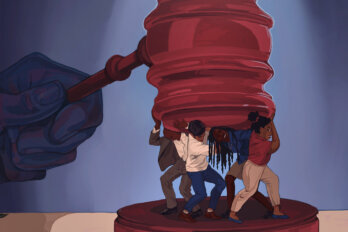I t is hard to imagine that one case could encapsulate so much of what is wrong with our legal system, but Castor Holdings came close. It was the longest case in Canadian legal history and the most lucrative litigation file in the history of Heenan Blaikie, one of the country’s highest-profile law firms. The case was the largest single source of revenue for Heenan’s Montreal office for many years. It lasted for twenty years—half the lifespan of Heenan Blaikie and longer than most lawyers spent at the firm. Some devoted their entire careers to working on the case. For the Montreal office, it was the largest single source of billings, a cash cow that kept five to ten lawyers busy over two decades. The billings each year were in the millions.
In 1992, Castor Holdings, a finance company, filed for bankruptcy, with over $1.6 billion in outstanding debts. That same year, Wolfgang Stolzenberg, one of the founders of Castor Holdings and its chief executive officer, snuck out the back door from a creditors’ meeting and disappeared. He was believed to have fled to his native Germany, with which Canada does not have an extradition treaty. In 2000, the Royal Canadian Mounted Police charged him with forty-one counts of fraud and conspiracy and issued a Canada-wide warrant for his arrest. He has never been arrested.
In 1994, the first of more than forty actions was launched against Castor Holdings and its auditors, Coopers and Lybrand. Widdrington Estate v. Wightman was selected as a test case. In this “simple” case, the issues were whether the financial statements of Castor Holdings were accurate and, if not, whether auditors Coopers and Lybrand were to blame. The plaintiffs expected the trial to take between six and eight months. Instead, it dragged on for more than twelve years.
The case continued for such a long time because of the deep pockets funding the lawyers for both sides and because of ineffective management by the first trial judge. The demise of Castor Holdings had been the biggest investment failure at the time, and money was no object on either side. The trustee in bankruptcy funded the plaintiffs’ counsel and reported spending over $72 million in lawyers’ fees in an effort to collect the more than $1.6 billion owed to creditors. On the defence side, the insurers for Coopers and Lybrand paid Heenan Blaikie’s bills, which were probably of a similar magnitude.
Clément Gascon headed up Heenan’s defence team until his appointment to the bench in 2002. Some said he was relieved to escape the case. Yvan Bolduc took on leadership of the team, which over time included many lawyers, paralegals, stagiaires, and students.
The trial of the action began in 1998, and the judgment was issued in 2011. An appeal to the Quebec Court of Appeal was dismissed in 2013. In January 2014, the Supreme Court of Canada refused to hear a further appeal. The case had finally reached its end, and a month later, Heenan Blaikie would also be finished.
F or Heenan, the Castor file was manna from heaven. However, for some of the lawyers who worked on the never-ending case, it was a prison. The trial, held at the Quebec Superior Court, was all consuming. Judge Paul Carrière set a punishing schedule: the trial proceeded for four days each week and for three weeks out of four a month, sometimes even four weeks out of four. When the lawyers were not in court, they were preparing for it. There was work every evening and every weekend; it was a 24/7 commitment. As one lawyer noted, “When you undertake a case of this magnitude, you have to be ready to make the commitment to see it through, but nobody imagined that it would last as long as it did.”
The Heenan lawyers had an office at the courthouse where they scanned every document and kept track of the more than 18,000 exhibits. The courtroom had to be retrofitted for the case: the seats were taken out and replaced with filing cabinets to house the exhibits, including over 100,000 pages of expert reports. Lawyers described the trial as “crazy” and the ninety-three cabinets of court documents as “inhuman.” Leonard Flanz, a lawyer for the plaintiffs, described the case as a potent example of how the justice system should not work. The plaintiffs’ expert witnesses testified for more than three and a half years: four days a week, three weeks a month, ten months a year.
In a case like this one, there is bound to be a lot of finger pointing. Heenan lawyers blamed the plaintiffs’ lawyers, claiming they had decided to attack everything in the audited financials and the auditors’ working paper. The defence lawyers felt they had no choice but to respond to this shotgun attack strategy. The plaintiffs’ lawyers blamed the Heenan lawyers, and other courts seemed to agree, using such phrases as “a procedural war of attrition” and “scorched earth strategies” to describe Heenan’s defence.
Trials are frequently compared to combat, and as in war, people working together under such intense conditions often develop strong bonds. Lawyers on the Castor Holdings case would return after a long day at trial and sit down to talk about the case and other matters. Working on a long trial is like running a long-distance marathon. The adrenalin keeps you going, but it takes a toll. The pace, intensity, and stress of the lengthy case were punishing. Lawyers who worked on it needed physical and mental fortitude to sustain themselves through the exhausting trial. Castor Holdings wasn’t a regular marathon; it was a double Ironman challenge.
Stress is a well-known trigger for mental health issues, and in recent years, the prevalence of stress-induced conditions, including addiction, burnout, and depression, in the Canadian legal profession has been well documented. Gascon has taken a leadership role by speaking openly about his own mental health struggles over his career as a lawyer and as a Supreme Court justice. During the Castor Holdings case, he had what was believed to be a mental health episode and was not able to continue for several months. The proceedings were put on hiatus until he returned. He is unlikely to have been the only one whose mental health suffered due to the stress of the case.
Litigation is largely a younger lawyer’s game, and most of the lawyers who worked on Castor Holdings were in their forties or fifties. Judge Carrière was in his sixties, and the trial took a toll on him from which he never recovered. He fell ill and needed emergency bypass surgery. Although it became clear that he could not continue with the case, he waited a year after his surgery before finally removing himself. Nothing happened for more than six months, until the chief justice finally intervened and replaced Carrière with Justice Marie St-Pierre.
The replacement of a judge mid-trial is highly unusual but not unprecedented. It further delayed the proceedings, but St-Pierre took charge and did what Carrière had failed to do: she effectively managed the case. A smart and diligent judge who did not suffer fools gladly, St-Pierre focused on moving ahead as quickly as possible without limiting the rights of the parties. She imposed time limits and successfully brought the trial to an end in the fall of 2010. She issued her over-800-page decision in 2011. The next year, she was appointed to the Quebec Court of Appeal, along with Gascon, the original head of Heenan’s Castor Holdings litigation team.
T he Castor Holdings saga was an epic fail, not only for the Quebec Superior Court but also for the entire Canadian legal system. It revealed the judicial system at its worst: how lawyers can hijack it for more than a decade; how a well-meaning but short-sighted and ineffective trial judge can lose sight of the larger issues of justice in the name of process; and how preventive measures are limited by the system’s structure, its overreliance on individuals, and its fidelity to judicial independence.
Writing in 1999, former Supreme Court justice Rosalie Silberman Abella criticized the civil justice system’s obsession with rules, process, and procedure. She believed it had lost sight of its end goal, which is the fair resolution of disputes, not the “elaborate procedural journey” it had become. Abella wrote, “The effect of our exaggerated contentious procedure is not only to irritate parties, witnesses and jurors in particular cases, but to give to the whole community a false notion of the purpose and end of law.” She probably didn’t have the Castor Holdings case in mind, but her insights certainly pertain to it.
Our legal system relies too much on individuals and not enough on teams or systems. Having the wrong person in place can freeze proceedings and send ripple effects throughout the system and into the lives of many people. At Heenan Blaikie, Bolduc was not interested in settling the Castor Holdings case. Justice Carrière took a hands-off approach and did not push for settlement. He was a meticulous judge, but he mistook process for fairness and justice. Almost everyone realized that the case was obviously going off the rails, but there was no mechanism for the chief justice or any other party to intervene and provide direction to Carrière. To have done so would have been seen as a violation of the sacrosanct principle of judicial independence. However, the countervailing principle of justice was sacrificed.
There is no data on the impact the Castor Holdings litigation had on other cases in the Quebec legal system, but judicial and court resources are limited, so it inevitably did have an effect. It hoovered up scarce public resources that could have been used by others. No one seems willing to ask hard questions about the ramifications of large, long cases: How many people spend extra time in jail, forced to wait until the next available court date comes up? How many parents are delayed in getting an access order to see their children?
S trictly speaking, Castor Holdings was a loss for Heenan Blaikie. Heenan lost at trial and at the Quebec Court of Appeal, and the Supreme Court refused to hear the case. But despite losing the longest case in Canadian history and countless appeals before, during, and after the trial, the lawyers at Heenan Blaikie certainly did not see Castor Holdings as a defeat. For more than a decade, it had been the goose that laid the golden egg in the Montreal office.
The former partners of Coopers and Lybrand probably felt differently about both the case and Heenan’s “scorched earth” litigation strategy. Combined with Carrière’s inept handling of the case, the defence strategy led to the exhaustion of the insurance funds for Coopers and Lybrand, and when the case ultimately settled (when Heenan was no longer counsel), some former Coopers and Lybrand partners were required to personally contribute $74.5 million to the settlement.
Working so intensely for so long on one case can take a toll both professionally and personally. These were monstrous files. Some Heenan lawyers felt a loss of control, like falling off a cliff; their practices dried up, and their work lives became psychologically difficult. For years, people had made sacrifices in their personal lives while working on these big cases.
Law firms have never been particularly good at managing workflow, and Heenan was certainly no exception. Law firms are also notoriously amateurish when it comes to project management. Teams are often put together haphazardly based on the personal preferences of the lead lawyer, the immediate availability of other lawyers, and so on. If additional support is needed, lawyers may be hired into full-time, permanent positions without much thought about the long-term staffing needs of the group or the department after the big case or the big transaction is over. In recent years, large law firms have moved away from this approach, placing greater emphasis on outsourcing, insourcing, and contract hiring for specific projects. But in the 1990s and 2000s, ad hoc staffing was the order of the day.
The Castor Holdings file reflected a pattern at Heenan Blaikie of relying on the big score instead of developing a coherent business vision. In Toronto, the firm was also handling the Atomic Energy of Canada Limited private arbitration case, which also involved $1.6 billion in claims. Between 2009 and 2012, the arbitration kept eight to twelve Heenan lawyers busy. Some people billed 200 hours a month for three years while working on AECL.
The AECL arbitration decision was rendered after Labour Day 2012, and the case settled in the summer of 2013. The end of arbitration left many in Heenan’s Toronto office worried. As one Heenan lawyer quipped, “We won the case, but they did not appeal.” The massive fees had masked the impact of the economic tailspin that had begun in 2008. People myopically believed that the firm was impervious to the recession. Many who worked on AECL saw their workflow radically reduced after the case ended.
With the resolution of Castor Holdings and AECL, Heenan’s luck had finally run out. In Montreal and Toronto, a lot of lawyers were sitting around with little to do.
For law firms, idle labour is an expensive proposition. Large firms such as Heenan Blaikie lease high-end, costly offices, like in 1250 René-Lévesque in Montreal and Bay Adelaide in Toronto. They provide secretarial and other administrative support for lawyers, and they pay the lawyers’ high salaries. Lawyers’ high overhead is covered by their billings. They must bill at least double their salary just to cover their costs. In other businesses, workers who have nothing to do would be laid off. But that was not the Heenan Blaikie way: here, you had a job for life. There was something admirable and romantic about that notion, but ultimately, the Heenan partners could no longer ignore the fact that the firm was a business.
At Heenan Blaikie, information about finances, profitability, and operation was closely guarded. It was not shared with the partners, who behaved more like employees than business owners. There was precious little planning: no strategic planning, no succession planning, no planning for the end of big cases, and no planning for an economic slump. Ultimately, it was decisions made and not made in Montreal and Toronto that led to the firm’s collapse in 2014.
Adapted and excerpted with permission from Heenan Blaikie: The Making and Unmaking of a Great Canadian Law Firm by Adam Dodek, 2024, UBC Press, Vancouver, Canada.





